Biology:Aracari
| Aracaris | |
|---|---|
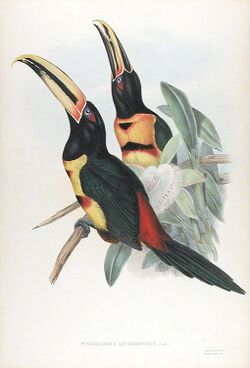
| |
| Pale-mandibled aracari Pteroglossus erythropygius | |
| Scientific classification | |
| Domain: | Eukaryota |
| Kingdom: | Animalia |
| Phylum: | Chordata |
| Class: | Aves |
| Order: | Piciformes |
| Family: | Ramphastidae |
| Genus: | Pteroglossus Illiger, 1811 |
| Type species | |
| Ramphastos aracari (black-necked aracari) Linnaeus, 1758
| |
| Species | |
|
14 (incl. the saffron toucanet), see text. | |
| Synonyms | |
|
List
| |
An aracari or araçari (US: /ˌɑːrəˈsɑːri/ AR-ə-SAR-ee,[1] UK: /ˌærəˈsɑːri/ ARR-ə-SAR-ee, /-ˈkɑːri/ -KAR-ee)[2] is any of the medium-sized toucans that, together with the saffron toucanet, make up the genus Pteroglossus.
They are brightly plumaged and have enormous, contrastingly patterned bills. These birds are residents in forests and woodlands in the Neotropics.
Taxonomy
The genus Pteroglossus was introduced in 1811 by the German zoologist Johann Karl Wilhelm Illiger.[3] The name combines the Ancient Greek pteron meaning "feather" with glōssa meaning "tongue".[4] George Robert Gray designated the black-necked aracari as the type species of the genus in 1840.[5][6]
The name "Aracari" was used in 1648 by the German naturalist Georg Marcgrave for the black-necked aracari in his book Historia Naturalis Brasiliae.[7] The name comes from the word Arassari, the name of the bird in the Tupi language.[8]
One species, the distinctive saffron toucanet, was formerly placed in the monotypic genus Baillonius, but Renato Kimura and collaborators showed in 2004 that it belongs in the genus Pteroglossus.[9][10]
A 2010 molecular phylogenetic study by Swati Patel and collaborators found that the brown-mandibled aracari was nested with the subspecies of the ivory-billed aracari:[11]
| Pteroglossus |
| ||||||||||||||||||||||||||||||||||||||||||||||||||||||||||||||||||||||||||||||||||||
Extant species
Fourteen species are considered to belong to the genus Pteroglossus:[12]
| Image | Scientific name | Common Name | Distribution |
|---|---|---|---|
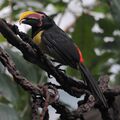 |
Pteroglossus viridis | Green aracari | lowland forests of northeastern South America (the Guiana Shield), in the northeast Amazon Basin, the Guianas and the eastern Orinoco River drainage of Venezuela |
 |
Pteroglossus inscriptus | Lettered aracari | Bolivia, Brazil, Colombia, Ecuador, and Peru |
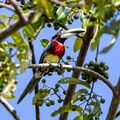 |
Pteroglossus bitorquatus | Red-necked aracari | Bolivia and Brazil |
 |
Pteroglossus azara | Ivory-billed aracari | Bolivia, Brazil, Colombia, Ecuador, Peru, and Venezuela |
 |
Pteroglossus mariae | Brown-mandibled aracari | Bolivia, Brazil, and Peru |
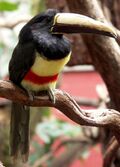 |
Pteroglossus aracari | Black-necked aracari | Brazil, French Guiana, Guyana, Suriname, and Venezuela |
 |
Pteroglossus castanotis | Chestnut-eared aracari | Amazon Basin, Paraguay, Bolivia, southeastern Brazil and the extreme northeast of Argentina |
 |
Pteroglossus pluricinctus | Many-banded aracari | Brazil, Colombia, Ecuador, Peru, and Venezuela |
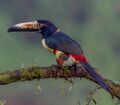 |
Pteroglossus torquatus | Collared aracari | southern Mexico to Panama; also Ecuador, Colombia, Venezuela and Costa Rica |
 |
Pteroglossus sanguineus | Stripe-billed aracari | Colombia and Ecuador |
 |
Pteroglossus erythropygius | Pale-mandibled aracari | Ecuador and Peru |
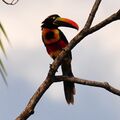 |
Pteroglossus frantzii | Fiery-billed aracari | southern Costa Rica and western Panama |
 |
Pteroglossus beauharnaisii | Curl-crested aracari | Amazon Basin |
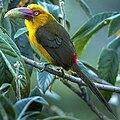 |
Pteroglossus bailloni | Saffron toucanet | Brazil |
Former species
Some authorities, either presently or formerly, recognize additional species or subspecies as species belonging to the genus Pteroglossus including:
- Wagler's toucanet (as Pteroglossus wagleri)[13]
- Emerald toucanet (as Pteroglossus prasinus)[14]
- White-throated toucanet (as Pteroglossus albivitta)[15]
- Black-throated toucanet (as Pteroglossus atrogularis)[16]
- Groove-billed toucanet (as Pteroglossus sulcatus)[17]
- Crimson-rumped toucanet (as Pteroglossus haematopygus)[18]
- Guianan toucanet (as Pteroglossus Culik)[19]
- Golden-collared toucanet (as Pteroglossus reinwardtii)[20]
- Langsdorff's toucanet (as Pteroglossus langsdorffii)[21]
- Tawny-tufted toucanet (as Pteroglossus nattereri)[22]
- Gould's toucanet (as Pteroglossus gouldii)[23]
- Spot-billed toucanet (as Pteroglossus maculirostris)[24]
- Gray-breasted mountain toucan (as Pteroglossus hypoglaucus)[25]
- Hooded mountain toucan (as Pteroglossus cucullatus)[26]
- Black-billed mountain toucan (as Pteroglossus nigrirostris)[27]
Behaviour and ecology
Some species of aracaris are unusual for toucans in that they roost socially throughout the year, up to six adults and fledged young sleeping in the same hole with tails folded over their backs.
Breeding
They are arboreal and nest in tree holes laying 2–4 white eggs.
Food and feeding
All the species are basically fruit-eating, but will take insects and other small prey.
Threats
The ischnoceran louse Austrophilopterus flavirostris is suspected to parasitize most if not all species of aracaris, with the possible exception of the green aracari (Price & Weckstein 2005).
References
- ↑ "Aracari". Dictionary.com Unabridged. Random House, Inc.). http://dictionary.reference.com/browse/aracari?s=t.
- ↑ "Definition for aracari". Oxford Dictionaries Online. http://oxforddictionaries.com/definition/aracari?q=aracari.
- ↑ Illiger, Johann Karl Wilhelm (1811) (in Latin). Prodromus systematis mammalium et avium. Berolini [Berlin]: Sumptibus C. Salfeld. p. 202. https://www.biodiversitylibrary.org/page/29301172.
- ↑ Jobling, James A. (2010). The Helm Dictionary of Scientific Bird Names. London: Christopher Helm. p. 322. ISBN 978-1-4081-2501-4. https://archive.org/stream/Helm_Dictionary_of_Scientific_Bird_Names_by_James_A._Jobling#page/n322/mode/1up.
- ↑ Gray, George Robert (1840). A List of the Genera of Birds : with an Indication of the Typical Species of Each Genus. London: R. and J.E. Taylor. p. 50. https://www.biodiversitylibrary.org/page/13668967.
- ↑ Peters, James Lee, ed (1948). Check-List of Birds of the World. 6. Cambridge, Massachusetts: Harvard University Press. p. 74. https://www.biodiversitylibrary.org/page/14477507.
- ↑ Marcgrave, Georg (1648) (in Latin). Historia Naturalis Brasiliae: Liber Quintus: Qui agit de Avibus. Lugdun and Batavorum (London and Leiden): Franciscum Hackium and Elzevirium. p. 217. https://www.biodiversitylibrary.org/page/289309#page/362/mode/1up.
- ↑ Jobling, James A. (2010). The Helm Dictionary of Scientific Bird Names. London: Christopher Helm. p. 52. ISBN 978-1-4081-2501-4. https://archive.org/stream/Helm_Dictionary_of_Scientific_Bird_Names_by_James_A._Jobling#page/n52/mode/1up.
- ↑ Kimura, R.K.; Pereira, S.L.; Grau, E.T.; Höfling, E.; Wajntal, A. (2004). "Genetic distances and phylogenetic analysis suggest that Baillonius Cassin, 1867 is a Pteroglossus Illiger, 1811 (Piciformes: Ramphastidae)". Ornitologia Neotropical 15: 527–537. https://sora.unm.edu/node/119613.
- ↑ Remsen, J.V. Jr (2004). "Proposal 151: Merge Baillonius into Pteroglossus". South American Classification Committee, American Ornithologists' Union. http://www.museum.lsu.edu/~Remsen/SACCprop151.htm.
- ↑ Patel, S.; Weckstein, J.D.; Patané, J.S.L.; Bates, J.M.; Aleixo, A. (2011). "Temporal and spatial diversification of Pteroglossus araçaris (AVES: Ramphastidae) in the neotropics: Constant rate of diversification does not support an increase in radiation during the Pleistocene". Molecular Phylogenetics and Evolution 58 (1): 105–115. doi:10.1016/j.ympev.2010.10.016.
- ↑ Gill, Frank; Donsker, David; Rasmussen, Pamela, eds (August 2022). "Jacamars, puffbirds, barbets, toucans, honeyguides". IOC World Bird List Version 12.2. International Ornithologists' Union. https://www.worldbirdnames.org/bow/jacamars/.
- ↑ "Aulacorhynchus wagleri - Avibase". http://avibase.bsc-eoc.org/species.jsp?lang=EN&avibaseid=8A785F55&sec=summary&ssver=1.
- ↑ "Aulacorhynchus prasinus - Avibase". http://avibase.bsc-eoc.org/species.jsp?avibaseid=B35771C79152F9B3.
- ↑ "Aulacorhynchus albivitta - Avibase". http://avibase.bsc-eoc.org/species.jsp?lang=EN&avibaseid=D9578239&sec=summary&ssver=1.
- ↑ "Aulacorhynchus atrogularis - Avibase". http://avibase.bsc-eoc.org/species.jsp?lang=EN&avibaseid=F2FFAA9B&sec=summary&ssver=1.
- ↑ "Aulacorhynchus sulcatus - Avibase". http://avibase.bsc-eoc.org/species.jsp?avibaseid=96711EDE05847B28.
- ↑ "Aulacorhynchus haematopygus - Avibase". http://avibase.bsc-eoc.org/species.jsp?avibaseid=23DB835648606957.
- ↑ "Selenidera piperivora - Avibase". http://avibase.bsc-eoc.org/species.jsp?avibaseid=92FB567FBC5845D8.
- ↑ "Selenidera reinwardtii - Avibase". http://avibase.bsc-eoc.org/species.jsp?avibaseid=6AAA613244629521.
- ↑ "Selenidera reinwardtii langsdorffii - Avibase". http://avibase.bsc-eoc.org/species.jsp?lang=EN&avibaseid=5A81652E&sec=summary&ssver=1.
- ↑ "Selenidera nattereri - Avibase". http://avibase.bsc-eoc.org/species.jsp?avibaseid=82C29C2F6F37481D.
- ↑ "Selenidera gouldii - Avibase". http://avibase.bsc-eoc.org/species.jsp?avibaseid=39C1655E257495CD.
- ↑ "Selenidera maculirostris - Avibase". http://avibase.bsc-eoc.org/species.jsp?lang=EN&avibaseid=F0C12CF9&sec=summary&ssver=1.
- ↑ "Andigena hypoglauca - Avibase". http://avibase.bsc-eoc.org/species.jsp?lang=EN&avibaseid=B02554D83393F363.
- ↑ "Andigena cucullata - Avibase". http://avibase.bsc-eoc.org/species.jsp?avibaseid=D5746888EA67F2FB.
- ↑ "Andigena nigrirostris - Avibase". http://avibase.bsc-eoc.org/species.jsp?avibaseid=64516AE0ACD1E341.
- Price, Roger D. & Weckstein, Jason D. (2005): The genus Austrophilopterus Ewing (Phthiraptera: Philopteridae) from toucans, toucanets, and araçaris (Piciformes: Ramphastidae). Zootaxa 918: 1–18. PDF fulltext
Wikidata ☰ Q1076011 entry
 |

